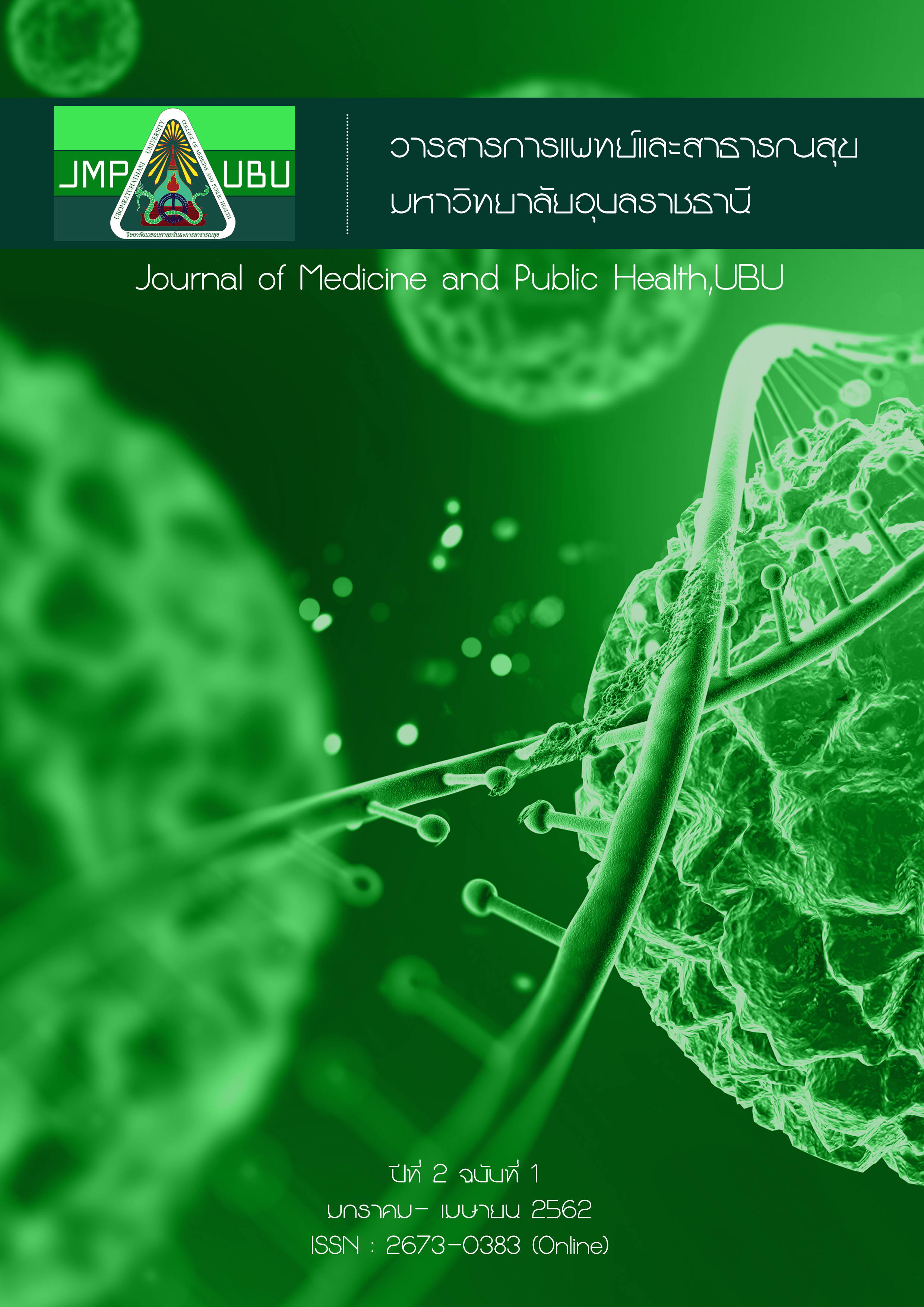ปัจจัยที่มีความสัมพันธ์กับการรอดชีพผู้ป่วยมะเร็งท่อน้ำดีภายหลังได้รับการรักษาด้วยการผ่าตัดในกลุ่มที่สามารถผ่าตัดแล้วหายขาดจากโรค
คำสำคัญ:
มะเร็งท่อน้ำดี, การผ่าตัดในกลุ่มที่สามารถผ่าตัดแล้วหายขาดจากโรค, อัตราการรอดชีพ, ปัจจัยพยากรณ์บทคัดย่อ
ภาคตะวันออกเฉียงเหนือ ประเทศไทย มีอุบัติการณ์มะเร็งท่อน้ำดีสูงเป็นอันดับหนึ่งของโลก และเป็นสาเหตุการตายอันดับต้นของคนไทย การผ่าตัดเป็นแนวทางการรักษาที่ดีที่สุดในผู้ป่วยกลุ่มนี้ การศึกษาครั้งนี้มีวัตถุประสงค์เพื่อศึกษาอัตราการรอดชีพและปัจจัยที่มีความสัมพันธ์กับการรอดชีพผู้ป่วยมะเร็งท่อน้ำดีภายหลังได้รับการรักษาด้วยการผ่าตัดในกลุ่มที่สามารถผ่าตัดแล้วหายขาดจากโรค (Curative resection) วิธีดำเนินการวิจัย ใช้การศึกษาแบบ Retrospective cohort study ในผู้ป่วย 126 รายที่ได้รับการวินิจฉัยและการผ่าตัดในกลุ่มที่สามารถผ่าตัดแล้วหายขาดจากโรคในโรงพยาบาลร้อยเอ็ด ระหว่างวันที่ 1 มกราคม 2557 ถึง 31 ธันวาคม 2560 หลังจากนั้นติดตามผู้ป่วยทุกรายอย่างต่อเนื่องจนกระทั่งทราบสถานะสุดท้ายของการเสียชีวิต ถึงวันที่ 31 ธันวาคม 2561 นำข้อมูลมาคำนวณหาอัตราการรอดชีพโดยวิธี Kaplan-Meier method และใช้ Cox proportional hazard model เพื่อวิเคราะห์หาความสัมพันธ์ของปัจจัยต่างๆกับการรอดชีพ ผลการศึกษาพบว่า ผลรวมของระยะเวลาของผู้ป่วยในแต่ละรายตั้งแต่เข้ามาในการศึกษาจนเสียชีวิตเท่ากับ 4,085 คน-เดือน อุบัติการณ์การเสียชีวิตเท่ากับ 17.0 ต่อ100 คน-ปี (95%CI: 13.1-22.0) อัตราการรอดชีพใน 1 และ 4 ปีเท่ากับ ร้อยละ 97.6 (95%CI: 92.8-99.2) และ 52.9 (95%CI: 41.1-63.5) ตามลำดับ ค่ามัธยฐานของระยะเวลาการรอดชีพหลังการผ่าตัดเท่ากับ 50.6 เดือน (95%CI: 33.9-54.3) เมื่อควบคุมผลกระทบจากตัวแปร เพศ อายุ Histological type, Histological grading, Macroscopic classification และ Resection margin พบว่า การแพร่กระจายของเซลล์มะเร็งไปต่อมน้ำเหลือง เป็นปัจจัยที่มีความสำคัญอย่างมีนัยสำคัญทางสถิติหลังการผ่าตัดในกลุ่มที่สามารถผ่าตัดแล้วหายขาดจากโรค โดย ผู้ป่วยที่มีการแพร่กระจายของเซลล์มะเร็งไปต่อมน้ำเหลือง เสี่ยงต่อการตาย 2.85 เท่าของกลุ่มที่ไม่มีการแพร่กระจายของเซลล์มะเร็งไปต่อมน้ำเหลือง (HR= 2.85; 95%CI: 1.48-5.47; p-value=0.002) สรุปผลการศึกษา การแพร่กระจายของเซลล์มะเร็งไปต่อมน้ำเหลือง เป็นปัจจัยสำคัญต่ออัตราการรอดชีพหลังผ่าตัด โดยในกรณีที่ไม่มีการแพร่กระจายของเซลล์มะเร็งไปต่อมน้ำเหลือง จะลดความเสี่ยงต่อการตายได้ ร้อยละ 65.0
References
2. Altaee MY JP, Farrant JM, Williams R. Etiologic and clinical characteristics of peripheral and hilar cholangiocarcinoma.
Cancer. 1991 (68): 2051–5.
3. Burke EC JW, Hochwald SN, Pisters PW, Fong Y, Blumgart H. Hilar cholangiocarcinoma: Patterns of spread, the importance of hepatic resection for curative operation, and a presurgical clinical staging system. Ann Surg. 1998 (228): 385–94.
4. ณรงค์ ขันตีแก้ว. โรคมะเร็งท่อน้ำดี (Cholangiocarcinoma). ศรีนครินทร์เวชสาร. 2548 (20): 43–9.
5. Tyson GL E-SH. Risk factors for cholangiocarcinoma.Hepatology. 2011(54): 173–84.
6. Bergquist A, von Seth E. Epidemiology of cholangiocarcinoma. Best Pract Res Clin Gastroenterol. 2015 (2): 221–32.
7. Khuntikeo N, Chamadol N, Yongvanit P, Loilome W, Namwat N, Sithithaworn P. et al. Cohort profile: cholangiocarcinoma screening and care program (CASCAP). BMC Cancer. Available at: https://www.ncbi.nlm.nih.gov/
pmc/articles/PMC4459438/
8. Titapun A, Pugkhem A, Luvira V, Risuk T, Somintara O, Saeseow O-T et al. Outcome of curative resection for perihilar cholangiocarcinoma in Northeast Thailand. World J Gastrointest Oncol. 2015; 7(12): 503–12.
9. National Cancer Institute. Cancer incidence in Thailand 2016: Cancer in Thailand 2016. Bangkok: National Cancer Institute; (15; 2018).
10. Srivatanakul P, Sriplung H, Deerasamee S. Epidemiology of liver cancer: An Overview. Asian Pacific J Cancer
Prevention. 2004 (5): 118–25.
11. Khuntikao N. Current Concept in Management of Cholangiocarcinoma Srinagarind Med J. 2005 20(3): 143-149.
12. Prachayakul V, Chaisayan S, Aswakul P, Deesomsak M. Clinical characteristics and treatment outcomes of patients with unresectable cholangiocarcinoma in Thailand: are there differences dependent on stent type? Asian Pac J Cancer Prev APJCP. 2013; 14 (1): 529–32.
13. Si A, Li J, Xiang H, Zhang S, Bai S, Yang P, et al. Actual over 10-year survival after liver resection for patients with intrahepatic cholangiocarcinoma. Oncotarget. 2017; 8 (27): 44521–32.
14. Kim HJ, Kim CY, Hur YH, Koh YS, Kim JC, Kim HJ, et al. Prognostic factors for survival after curative resection
of distal cholangiocarcinoma: perineural invasion and lymphovascular invasion. Surg 2014; 44 (10): 1879–86.
15. ไพบูลย์ เพ็ญสุวรรณ, ภาสกร โสดารัตน์, ยุทธพงษ์ ชํานาญเอื้อ, พุฒิพงศ์ ศักดิ์แสน, อรทัย สืบเมืองซ้าย. อัตราการรอดชีพของผู้ป่วยมะเร็งท่อน้ำดีและปัจจัยที่มีผลหลังการผ่าตัดในโรงพยาบาลร้อยเอ็ด. วารสารวิชาการสาธารณสุข. 2559 (1):137–46.
16. Kovitangkoon K, Putthanachote N, Sangsa N, Tomuen C, Pensuwan P, Sarakarn P. Factors effecting to survival of intrahepatic Cholangiocarcinoma after surgical treatment among admitted patients in Roi Et Hospital, Roi Et Province. J Prapokklao Hosp Clin Med Educ Cent. 2017(2):100–9.
17. Nakano M, Ariizumi S, Yamamoto M. Intrahepatic cholangiocarcinoma. Semin Diagn Pathol. 2017; 34(2): 160–6.
18. Schiffman SC, Reuter NP, McMasters KM, Scoggins CR, Martin RCG. Overall survival perihilar cholangiocarcinoma: R1 resection with curative intent compared to primary endoscopic therapy. J Surg Oncol. 2012; 105
(1): 91–6.
19. Kim HJ, Kim CY, Hur YH, Koh YS, Kim JC, Kim HJ, et al. Prognostic factors for survival after curative resection of distal cholangiocarcinoma: perineural invasion and lympho vascular invasion. Surg. 2014; 44 (10): 1879–86.
20. Ting C-F, Huang W-H, Feng C-L, Yu C-J, Peng C-Y, Su W-P, et al. Clinical factors associated with the survival of patients with intrahepatic cholangiocarcinoma. Adv Dig Med. 2016; 3(1): 11–7.
21. Ali SM, Clark CJ, Mounajjed T, Wu T-T, Harmsen WS, Reid-Lombardo KM, et al. Model to predict survival after surgical resection of intrahepatic cholangiocarcinoma: the Mayo Clinic experience. HPB. 2015; 17(3): 244–50.
22. Tabrizian P, Jibara G, Hechtman JF, Franssen B, Labow DM, Schwartz ME, et al. Outcomes following resection of intrahepatic cholangiocarcinoma. HPB. 2015; 17(4): 344– 51.
23. Schumacher M., Sauerbrei W, Schmoor C. Sample size considerations for the evaluation of prognostic factors in survival analysis. Statistics in Medicine. 2000; 19(4) : 441–52.
24. Jarnagin WR, Bowne W, Klimstra DS, Ben-Porat L, Roggin K, Cymes K, Fong Y, DeMatteo RP, D’Angelica M, Koea J, Blumgart LH. Papillary phenotype confers improved survival after resection of hilar cholangiocarcinoma. Ann Surg 2005; 241: 703-12.
Downloads
เผยแพร่แล้ว
How to Cite
ฉบับ
บท
License
เนื้อหาและข้อมูลในบทความที่ลงตีพิมพ์ในวารสารการแพทย์และสาธารณสุข มหาวิทยาลัยอุบลราชธานี ถือเป็นข้อคิดเห็นและความรับผิดชอบของผู้เขียนบทความโดยตรง ซึ่งกองบรรณาธิการวารสารไม่จำเป็นต้องเห็นด้วย หรือร่วมรับผิดชอบใด ๆ
บทความ ข้อมูล เนื้อหา รูปภาพ ฯลฯ ที่ได้รับการตีพิมพ์ในวารสารการแพทย์และสาธารณสุข มหาวิทยาลัยอุบลราชธานี ถือเป็นลิขสิทธิ์ของวารสารการแพทย์และสาธารณสุข มหาวิทยาลัยอุบลราชธานี กองบรรณาธิการไม่สงวนสิทธิ์ในการคัดลอกเพื่อการพัฒนางานด้านวิชาการ แต่ต้องได้รับการอ้างอิงที่ถูกต้องเหมาะสม





